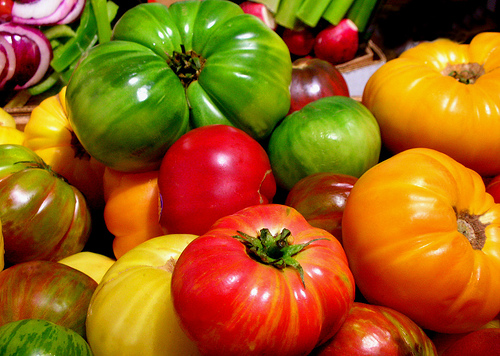Darin Engh, from Engh Gardens, explains what makes a vegetable an “heirloom” and picks some of his favorites.
The term “heirloom vegetable” has a warm, honey sound with overtones of old-fashioned goodness, but what does it really mean? A vegetable can be defined as an heirloom if it meets these three criteria:
1. It is a standard, open pollinated variety, rather than a hybrid, and thus its seeds will reproduce more faithfully. A hybrid, which is the result of deliberate cross-fertilization of two different varieties in a breeder’s greenhouse, has the characteristics of both parents, but any seed from it will not produce a plant that is liked itself, or, in the phrase used by many longtime gardeners, it “doesn’t come true from seed.” You can plant the seed of a hybrid, but there’s no telling what you’ll get. Open-pollinated plants, in contrast, are pollinated by natural forces (bees, wind, and so forth), and their seeds reproduce accurately.
2. It was introduce at least 50 years ago. Many heirlooms are much older, of course, but all contribute to this sense of history and continuity.
3. It has its own unique history. Many heirlooms were saved by individual farmers, their seeds passed down through the generations; some represent the horticultural endeavors of famous people; some are associated with specific events. But all, in one way or another, mean something in the history of gardening.
There is a continuing effort to preserve heirloom and other open-pollinated varieties that are in danger of being lost forever as new hybrid plant varieties push them out of the marketplace. Open-pollinated varieties produce seeds that are true to type, meaning they’re replicas of themselves. Over the years, farmers have selected the most desirable plants and saved their seeds for the next year’s crop. Heirlooms are specific strains that have been planted by farmers and gardeners for generations. The criteria that farmers and gardeners followed for saving heirlooms didn’t include modern marketing concerns like uniformity, transportability, or ease of growing in the widest possible range of climates. Rather, factors like taste and good performance in a specific region were of more importance.
In North America, immigrants brought their treasured foods in the form of seeds to provide a link to their past. Aware that the seeds might be taken from them, many gardeners and farmers hid them in place like clothing hems or suitcase linings. Immigrants smuggled them into this country in the lining of their hats, and in the hem of their dresses. Indigenous Americans shared their bounty of crops not know in pre-Columbian Europe with the first European settlers. The contributions of these two complex groups helped to create a rich and diverse selection of food plants that far exceeded that of any previous culture. We hope that recent and future immigrants will continue this tradition.
For most people the attraction of heirloom vegetables is their flavor. Heirloom varieties provide us many delightful vegetables not otherwise available, with wonderful flavor, unusual colors of shapes, and marvelous stories.
Heirloom varieties are not necessarily rare. You probably already grow a number of them – ‘Yellow Crookneck’ squash, ‘Blue Lake’ snap beans, ‘Detroit Dark Red’ beets, ‘Early Snowball’ cauliflower, ‘Armenian’ cucumbers.
Golden Bantam Sweet Corn – 1902, the old standard for sweet corn, sweet yellow kernels, cobs 6 inches long. This wonderful late summer treat makes a great complement to burgers, sandwiches, tomato plates and zucchini bread.
The fabulous array of lettuces are among our most ancient vegetables, having been cultivated by ancient Egyptians, Greeks, and Romans.
‘Reine des Glaces’ Head Lettuce – The French named this variety ‘Queen of the Ices’ for the crown-like appearance created by the spiky outer leaves. Large, crisp heads with excellent flavor.
‘Rossa di Trento’ Lettuce – Create a colorful salad with this delightful French variety. Crispy green leaves are adorned with a maroon outer edge.
Melons originated in the heat of West Africa, but most of the melons we know today were developed in Central Asia and brought here in the 1800s by immigrants.
‘Sakata’s Sweet’ Cantaloupe – Oriental melons are small, sweet, crunchy and have thin, edible rinds.
They can be eaten whole, like an apple. Vines can be grown on a trellis.
Potatoes originated in the High Andes. They are full of vitamins, minerals, some protein, and they are filled with slow-burning fuel and fiber.
‘Red Thumb’ Potato – With its red skin and flesh, this potato can turn ordinary dishes into something really different. Use for potato salad and French fries, or boil and eat unpeeled potatoes whole.
‘Rose Finn Apple Fingerling’ Potato – An heirloom variety which is increasingly popular with gourmet chefs. Pink skin and golden yellow flesh make it attractive. Their unique flavor, described as nutty or fruity, makes them irreplaceable for cooking. Great roasted, baked, or steamed.
‘Russian Banana’ Potato – A fingerling type with light brown skin and yellow flesh. This variety is prized as a boiling potato that holds together and will not crumble. Excellent flavor also makes it good baked or roasted. This is one of the most popular heirloom potato varieties because of its wonderful flavor and waxy texture. You won’t need to put butter on this fingerling!
‘Yellow Crookneck’ Squash – 1700, light yellow fruit with sweet mild-tasting white flesh. Meaty, fine-textured fruits have bumpy yellow skin and crooked necks. Very flavorful, great used raw in salads or steamed, fried or baked. Adds vibrant color to the dinner table.
‘Jarradale’ Pumpkin – this Austalian stringless variety is superb for baking. Gray-green shell conceals sweet, deep golden flesh. Difficult to find and easy to grow! ‘Jarradale’ will quickly become your favorite for Thanksgiving pumpkin pie.
‘Valenciano’ Pumpkin – these smallish pumpkins with unusually smooth, white skin make great Halloween decorations. The flesh is dense and sweet, making it a tough choice whether to eat them or use them as ornaments. Vigorous plants produce plenty of fruit with solid handles.
Tomatoes were domesticated more than two thousand years ago in Mexico and Central America. Although not the most common vegetable with the settlers two hundred years ago, tomatoes are certainly one of the most popular heirlooms today.
‘Brandywine’ Tomato – 1889, Pennsylvania, large pinkish red tomato, loved by many, this is the “gold standard” of tomato flavor and texture.
‘Glacier’ Tomato – Very early, delicious sweet heirloom variety. Cold tolerant and produces higher than average yields.
‘Japanese Oxheart’ Tomato – this cultivar is perfect for the smaller garden. The vines are reduced in size yet still produce large fruit. Wonderful for sauces and cooking.
For more information, you can visit Darin at Engh Gardens in Sandy or online at www.enghgardens.com.















Add comment